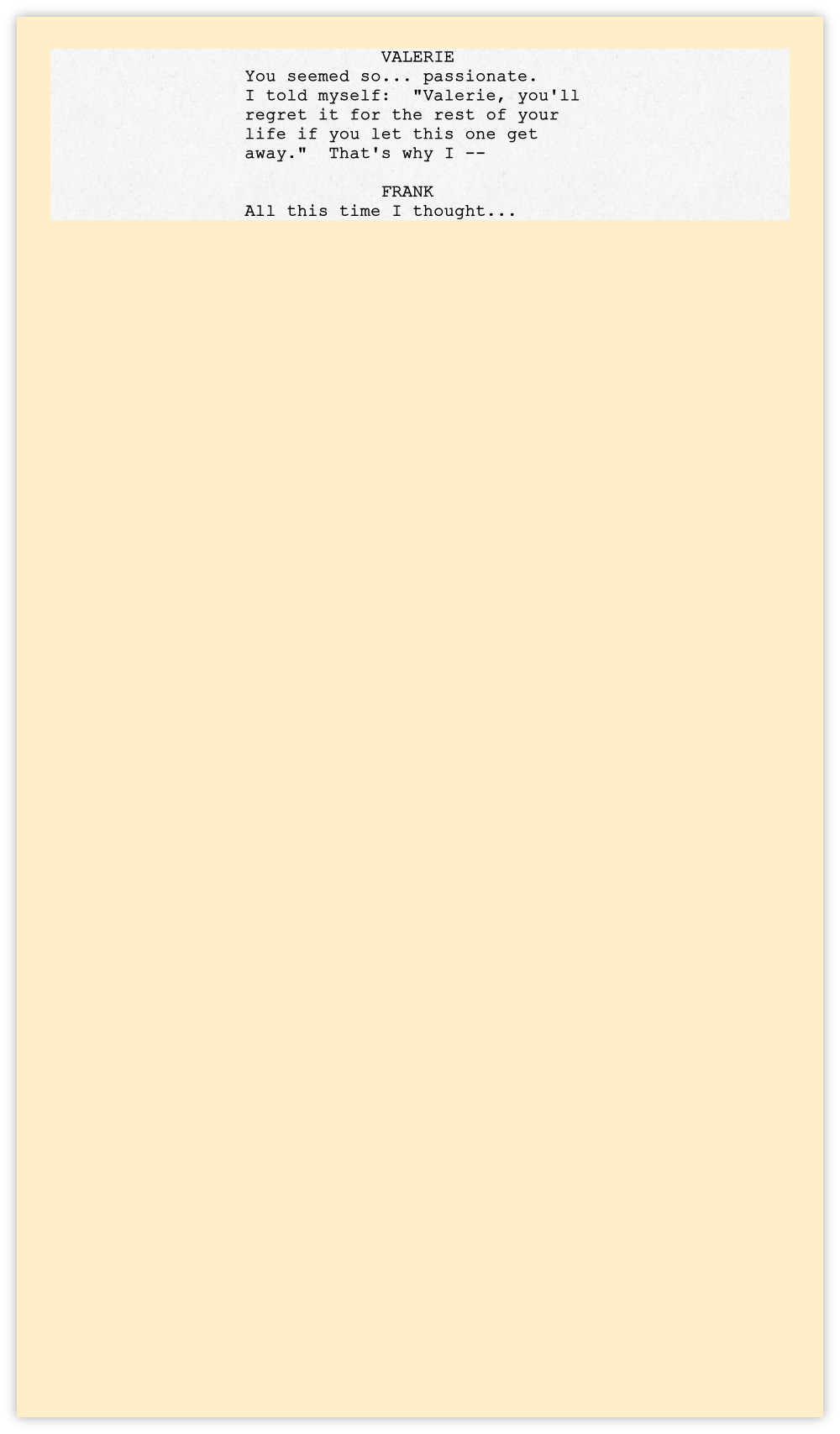

For more information: Recommended Links | Frequently Asked Questions
Copyright © 2018 by Michael Ray Brown. All rights reserved.
“First rate analysis at a cut-rate price.”
— Creative Screenwriting



Script Format: Dialogue
Dialogue should convey information and move the story forward, while at the same time help us understand the characters. Spice it up with slang and colloquialisms appropriate to their background. The relative sophistication of a character’s vocabulary, along with the phrasing and cadences of their speech, can provide clues to their education, upbringing and attitudes.
One mark of a mediocre script is that the characters confide what is on their minds or in their hearts. In the vernacular of the trade, this is called being “on the nose.” The subtext, or what a character leaves unsaid, is often more significant than what he or she says. If your characters keep their true thoughts and feelings hidden, your story will have greater tension and emotional resonance.
If one character addresses another by name, epithet, or title, that name should be set off with a comma. (“Master Weston, how cruelly you save yourself for the tennis court.”) This is an elementary rule of punctuation.
Spell out numbers when they appear in dialogue. Avoid using symbols and abbreviations in dialogue. This is partly a timing issue, to preserve the page-per-minute estimate in screenplays.
If a passage of dialogue includes some text that a character is reading out loud, this should be indicated with the word “reading” as personal direction. The text being read should be enclosed within quotation marks.
When a character recites poetry or song lyrics, enclose the lines in quotes. You may indicate the end of a line by means of a slash (“/”). This is preferable to ending each line with a hard return, as it does not alter the dialogue margins.
If one character interrupts another, then end the first character’s speech with an M-dash (a space followed by two hyphens), not with a period. Do not add an M-dash to the start of the second character’s speech. If the first character’s speech trails off, then end that speech with an ellipsis. If the second character finishes the first character’s sentence, then start the second character’s speech with an ellipsis.
When writing dialogue in two columns to indicate simultaneous speeches, the left margin of the first dialogue column must be inset slightly. It must not start in the same column as the action or description margin.
An initialism such as F.B.I. would be presented in dialogue as F – B – I, omitting the periods and using a hyphen flanked by spaces to separate each letter. This makes it clear that each letter should be spoken. Do not add hyphens in an acronym like NASA, which is pronounced as a word.
Never use ALL CAPS, bold, or italics in dialogue. Instead, underscore the word or phrase you wish to emphasize.
There is no standard way to indicate some passage of dialogue is in a foreign language. However, the most common way is to write the lines in English and enclose them in square brackets. When the first speech in a foreign language appears in the script, it’s generally accompanied by a note in parentheses:


Don’t center the dialogue. Each line should begin at the same column on the page (2.9 inches from the left edge being standard).
Screenplays have their own unique rules for breaking a page, rules your average word-processing software doesn’t follow. Those rules dictate that, among other things, dialogue may be broken only between sentences, not in mid-sentence. While there tends to be more flexibility when it comes to breaking description, the standard practice is to follow the same end-of-sentence rule.
When breaking a page in the middle of dialogue, it is customary to add the word “MORE” (in ALL CAPS and parentheses, but without the quotes) after the speech at the bottom of the page. This “(MORE)” appears on its own line at the same margin as the character cue:

To indicate the speech is continuing, insert the modifier “cont’d” (in lower case and enclosed within parentheses, but without the quotes) at the top of the next page, one space to the right of the character cue:

If there are only a few lines in a foreign language, it may be simpler just to use personal direction with the words “in Spanish,” for example.

| Development Notes |
| Oral Consultation |
| Studio-style Coverage |
| Selling Synopsis |
| Proofreading |
| Sample Script Analysis |
| Sample Coverage |
| Sample Selling Synopsis |
| SolPix Interview |
| Creative Screenwriting Interview |
| Scriptwriter Interview #1 |
| Scriptwriter Interview #2 |
| Scriptwriter Interview #3 |
| Scriptwriter Interview #4 |
| Elements of a Great Script |
| Margin Settings |
| Scene Headings |
| Slug Lines |
| Description |
| Character Cues |
| Dialogue |
| Personal Direction |
| Transitions |
| Flashbacks |
| Montages |
| Telephone Calls |
| Registration |
| Software |